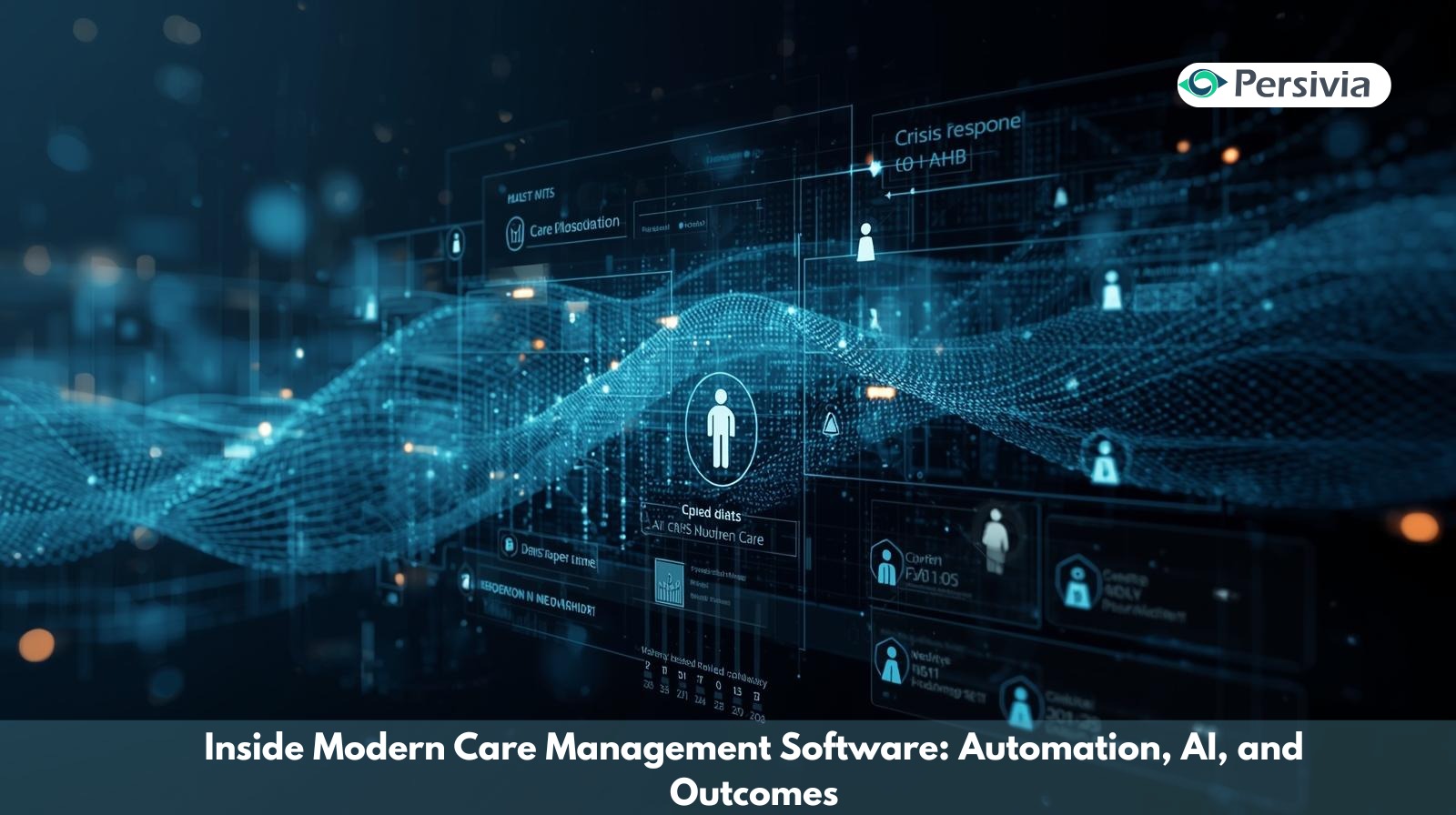Real-time risk stratification, care planning, and data integration, which can be performed with the help of AI, can be applied in modern care management platforms to minimize readmissions and decrease the workload of providers. These systems rely on thousands of evidence-based rules and clinical pathways to transform healthcare from crisis response to coordinated, proactive care.
The medical workers face growing pressure: readmission fines are growing, the patient population is growing, and the care teams are overstressed. The use of old systems and tools, such as spreadsheets, would no longer be able to support the current care coordination.
Contemporary care management software predicts the dangers of patients in advance and automates the routine work, and delivers evidence-based interventions at the right schedule. The results are the reduction of readmission, the decrease of time spent on manual work, and accelerated access to unified patient insights.
What is Care Management Software?
Care management software helps medical providers to arrange, track, and simplify patient care within different settings. It integrates clinical and claims information, patient-reported outcomes, device information, and social determinants into a single longitudinal dataset.
Modern platforms differ from legacy systems in three ways:
- Real-time integration: The data kept in EHRs, HIEs, claims systems, and patient devices is not updated in batches but continuously.
- Predictive capabilities: AI algorithms predict patients who are at high risk of readmission or complications
- Actionable workflows: At the point of care, the platform surfaces specific interventions, as opposed to static reports that need manual interpretation.
How AI and Machine Learning Transform Care Coordination
Artificial Intelligence processes the data of patients to detect any initial signs of danger and prescribe evidence-based and timely interventions. AI eases the platforms that examine unstructured and structured data, including lab values and diagnoses, clinical notes, discharge summaries, and evaluations. Machine learning models trained on millions of patient interactions identify patterns that are suggestive of deteriorating health.
Key AI applications:
- Risk stratification: Integrates clinical data, claims history, and social determinants to forecast hospitalizations, ED visits, and complications.
- Care gap identification: Flags missing screenings or follow-ups, non-adherence to medications, and unfinished follow-ups, which are in an evidence-based setting.
- Intervention prioritization: Prioritizes patients based on urgency and impact, thus enabling care managers to concentrate on high-value activities.
- Outcome prediction: Predicts patient outcomes in various care conditions.
Core Features That Drive Measurable Outcomes
The distinction between breakthrough results and incremental improvement is the extent to which platforms combine data, automate workloads, and provide insights.
Data Integration Across the Care Continuum
The clinical records, insurance claims, pharmacy fills, remote monitoring devices, patient portal entries, and community health worker assessments are assembled in a single view in modern platforms. The platform notifies the care team by morning when a patient arrives at the ED at 2 AM, which causes the outreach before the discharge gaps grow.
Personalized Care Plans Generated Automatically
Automated care plans save significant time for care teams and reduce administrative workload. Plans put into consideration comorbidities, social barriers, drug interactions, patient preferences, as well as program needs.
Automated care plans include:
- Evidence-based interventions tailored to patient conditions
- Scheduled touchpoints (calls, visits, assessments)
- Measurable goal milestones
- Care team member assignments
- Patient education materials matched to health literacy level
Point-of-Care Clinical Decision Support
When opening up to a patient with A1C levels over the normal range and diabetes, the platform detects the care gap, suggests changes in the prescription, notifies about the drug interactions, and suggests educational resources, which are all presented in the operation process. This decreases the cognitive load and provides uniformity of care across teams.
Risk Stratification Using Multiple Data Sources
AI-enabled risk stratification goes beyond diagnosis codes:
- Current disease progression markers
- Medication adherence patterns
- Social isolation indicators
- Food and housing stability
- Transportation access
- Mental health status
- Care team engagement levels
These are multifactor models that would be more accurate in predicting future utilization, which enables the care teams to segment the population and make a proportionate allocation of resources.
The Role of Evidence-Based Clinical Pathways
Standardized pathways minimize care variability and preserve flexibility, whereby every patient obtains the proven interventions.
State-of-the-art platforms consist of 200 or more in-built pathways in terms of chronic conditions, post-acute transitions, and preventive care. For example, a heart failure pathway might include daily weight checks, regular care team calls, dietary goals, and early warnings for potential complications.
The platform monitors compliance, notifies teams of deviation, and modifies recommendations on a patient status change. These channels also provide automatic adherence to the Medicare Shared Savings, bundle payment, and commercial risk contracts.
Workflow Integration and Care Team Efficiency
Technology adoption succeeds when platforms layer onto existing operations rather than forcing wholesale redesigns.
Effective platforms integrate with current EHR systems and support existing care team structures.
Key integration features:
- Bidirectional EHR interfaces for automatic data exchange
- Single sign-on through existing credentials
- Configurable dashboards matching team roles
- Mobile access for field-based staff
- API connections to third-party tools
Care managers log in each morning to prioritize worklists showing recently hospitalized patients, deteriorating vital signs from remote monitoring, medication refill gaps, and patients approaching risk thresholds. This makes high-impact interventions occur first.
The data from remote monitoring, glucose levels, blood pressure, and weight changes is directed to real-time dashboards. The threshold alerts will send instant notifications to the care manager so that they can intervene before patients contact 911 or visit the ED.
Advanced Analytics: Cost, Utilization, and Outcomes
Knowing the locations of the costs and what interventions can yield ROI are the differences that distinguish between the successful programs and those that fail.
Such platforms follow emergency visits, avoidable hospitalization, specialist use, cost of medication, and post-acute expenditure. A large proportion of patients incur a small but significant portion of the overall costs, and by targeting intensive care management of such a group, many health systems have seen significant savings in the overall health care expenditure.
Utilization analysis shows whether patients attend EDs with conditions that may be addressed by primary-care specialists, lack access to specialists, attend out-of-network providers, or do not receive follow-ups during post-discharge. Interventions are developed using these lessons.
Best care management software tracks clinical outcomes alongside financial metrics:
Clinical outcome dashboards track:
- Readmission rates by condition and timeframe
- Care gap closure percentages
- HbA1c, blood pressure, and cholesterol control rates
- Medication adherence scores
- Patient satisfaction metrics
- Quality measure performance
Why Outcomes Improve With Modern Platforms
The reduction in readmissions comes from moving away from reactive crisis management toward proactive risk mitigation. The conventional care management is a response lacking proactive care management. Predictive analytics are applied in modern platforms to spot potential at-risk patients prior to the crisis so that proactive intervention can be performed with the help of scheduled appointments, eliminating barriers to taking medications, connecting with community resources, and increasing monitoring intensity.
Platforms with thousands of built-in evidence-based rules standardize care while allowing customization. Every diabetic patient gets retinopathy screening. Every post-surgical patient receives infection prevention education. Every heart failure patient has documented self-management training. This lifts baseline performance across all care managers.
Automated care gap identification eliminates oversights. The platform constantly compares records to guidelines, identifies gaps, delegates duties, and closes. Loopholes that take months to fix can be solved in weeks.
Selecting the Right Digital Health Platform
Begin by setting clear objectives: lower readmissions, bridging value-based contract care gaps, or expanding care management without increased staff.
Platform Comparison: Legacy vs. Modern Systems
| Feature | Legacy Systems | Modern AI-Powered Platforms |
| Data Integration | Overnight batch updates | Real-time continuous updates |
| Risk Prediction | Rule-based, diagnosis codes only | AI-driven, multi-factor analysis |
| Care Plan Creation | Manual (30-45 min per patient) | Automated with personalization |
| Clinical Pathways | Custom-built, requires maintenance | 200+ built-in, evidence-based |
| Decision Support | Passive information display | Contextual recommendations at the point of care |
| Workflow | Static reports requiring interpretation | Intelligent prioritized worklists |
| Remote Monitoring | Separate systems, manual review | Integrated dashboards with threshold alerts |
| Analytics | Basic reporting | Predictive analytics with ROI tracking |
| Mobile Access | Limited or none | Full functionality for field teams |
| Outcome Tracking | Process measures only | Connected to actual patient outcomes |
Care management software vendors vary widely in capabilities, depth, and proven outcomes. When evaluating vendors, focus on these critical criteria:
Critical evaluation criteria:
- Evidence-based content depth: How many clinical rules and pathways come built-in vs. requiring custom configuration?
- AI maturity: True machine learning trained on patient outcomes, or basic rule-based logic labeled as AI?
- Integration capabilities: Which EHR systems, claims platforms, and HIEs connect natively?
- Implementation track record: What documented outcomes have similar organizations achieved?
- User experience: Will teams actually use it, or will poor design drive workarounds?
- Scalability: Can it handle growing patient volumes without performance degradation?
There are similarities in successful organizations: they have executive sponsorship, formation of implementation teams, and involvement of clinicians in design decisions, and adherence to workflow changes in the case of technology, providing a more effective strategy.
Takeaway
The contemporary care management software is a manifestation of the transformation of healthcare to a mode of proactive and coordinated care delivery as opposed to crisis management. Reducing readmissions and easing provider workload is achievable when supported by the right technology foundation. The healthcare organizations that are keen about the enhancement of the outcomes require platforms that offer evidence-based interventions throughout the continuum, detect risks prior to their development, and render the proactive management of care scalable.
About Persivia!Persivia offers an integrated care management platform that pursues patients through the whole care continuum using AI-based solutions. It provides your care teams with the right information at the point of care, enabling them to reap the benefits of its thousands of evidence-based algorithms, 200+ clinical pathways, and demonstrated results, including a 65% reduction in 30-day readmissions and an 85 % reduction in provider workload.








